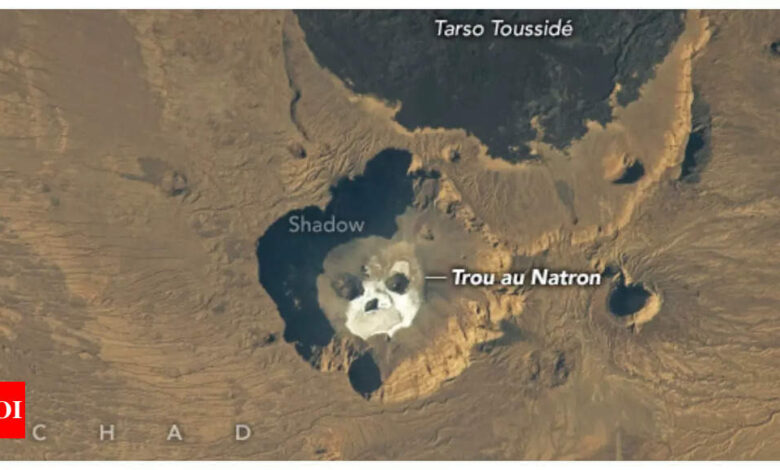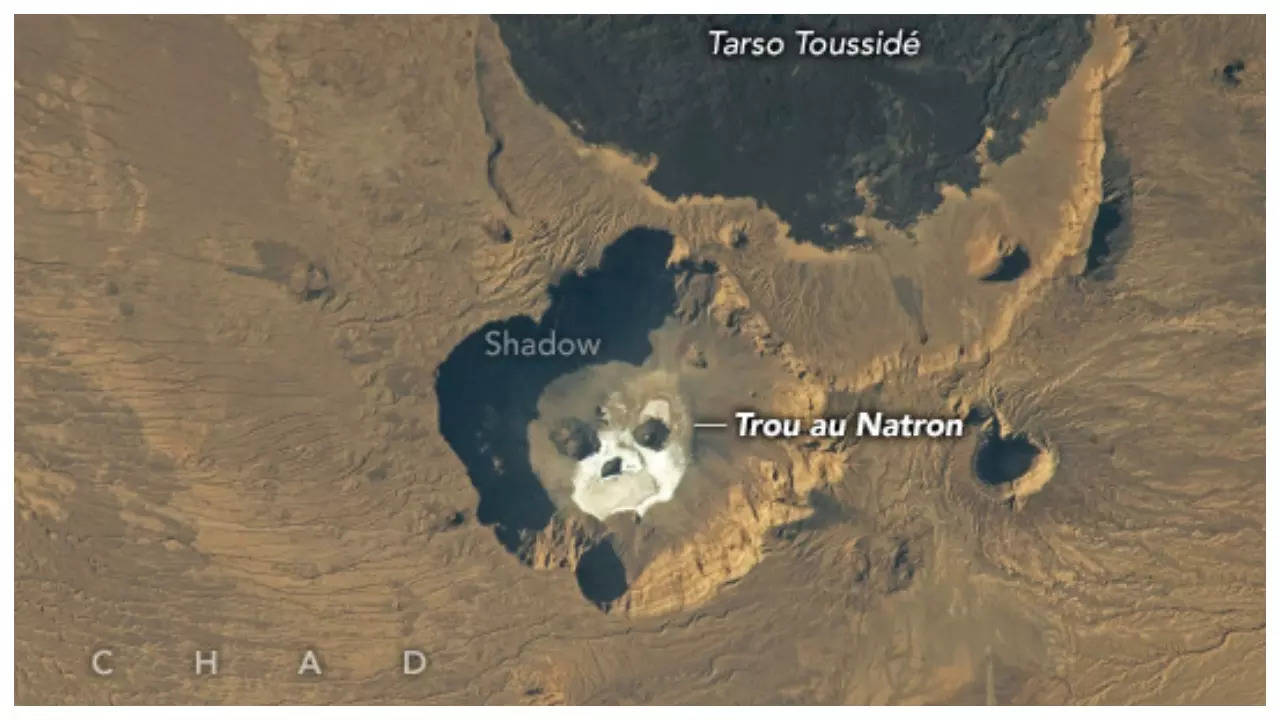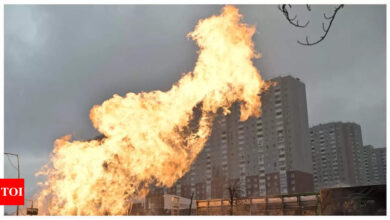World
A ghostly face in the rock: Nasa releases eerie image of ‘skull’ in a volcanic pit in Sahara

[ad_1]
NEW DELHI: The Trou au Natron, a volcanic pit and soda lake located in northern Chad, presents an eerie visage when viewed from above, resembling a ghostly face gazing upwards. This intriguing image was captured by an astronaut aboard the International Space Station on February 12, 2023.
The facial illusion is partly created by the shadows cast by the rim of a caldera—a specific type of volcanic crater that emerges either after a powerful eruption or when the surface collapses into a semi-drained magma chamber.The features that appear as “eyes” and “nose” are actually cinder cones, which are steep, cone-shaped hills that form around volcanic vents. These cinder cones are believed to be geologically young, having possibly formed within the last few million or even thousand years.
The “mouth” of the face is surrounded by a white mineral crust composed of natron—a salt blend of sodium carbonate, sodium bicarbonate, sodium chloride, and sodium sulfate. This crust forms when hot spring water accumulates on the surface, evaporates, and releases mineral-rich steam due to the geothermal activity in the area.
Located southeast of Tarso Toussidé, a prominent volcanic structure with fumaroles and an active stratovolcano, Trou au Natron is one of several volcanic peaks in the Tibesti Mountains. Its remote location poses challenges for scientific exploration. However, studies from rock and fossil samples gathered in the 1960s suggest that a glacial lake, hundreds of meters deep, once filled Trou au Natron around 14,000 years ago. A 2015 expedition led by German researcher Stefan Kröpelin managed to reach the site and collected fossilized aquatic algae samples believed to be approximately 120,000 years old.
Satellite observations have been instrumental in understanding the region further. Two researchers from the University of Cambridge have constructed a rough timeline of the area’s volcanic activity using data from Nasa’s Terra satellite’s ASTER sensor. Their findings indicate that the formation of Trou au Natron is among the more recent significant geological events in the region.
This captivating image, labeled ISS068-E-53507, was captured using a Nikon D5 digital camera with a 500-millimeter focal length. The photograph is a contribution from the ISS Crew Earth Observations Facility and the Earth Science and Remote Sensing Unit at the Johnson Space Center. The image has been modified to enhance its contrast and remove lens artifacts. The International Space Station Program encourages astronauts to capture valuable images of Earth for scientific and public benefit, ensuring their free accessibility online.
The facial illusion is partly created by the shadows cast by the rim of a caldera—a specific type of volcanic crater that emerges either after a powerful eruption or when the surface collapses into a semi-drained magma chamber.The features that appear as “eyes” and “nose” are actually cinder cones, which are steep, cone-shaped hills that form around volcanic vents. These cinder cones are believed to be geologically young, having possibly formed within the last few million or even thousand years.
The “mouth” of the face is surrounded by a white mineral crust composed of natron—a salt blend of sodium carbonate, sodium bicarbonate, sodium chloride, and sodium sulfate. This crust forms when hot spring water accumulates on the surface, evaporates, and releases mineral-rich steam due to the geothermal activity in the area.
Located southeast of Tarso Toussidé, a prominent volcanic structure with fumaroles and an active stratovolcano, Trou au Natron is one of several volcanic peaks in the Tibesti Mountains. Its remote location poses challenges for scientific exploration. However, studies from rock and fossil samples gathered in the 1960s suggest that a glacial lake, hundreds of meters deep, once filled Trou au Natron around 14,000 years ago. A 2015 expedition led by German researcher Stefan Kröpelin managed to reach the site and collected fossilized aquatic algae samples believed to be approximately 120,000 years old.
Satellite observations have been instrumental in understanding the region further. Two researchers from the University of Cambridge have constructed a rough timeline of the area’s volcanic activity using data from Nasa’s Terra satellite’s ASTER sensor. Their findings indicate that the formation of Trou au Natron is among the more recent significant geological events in the region.
This captivating image, labeled ISS068-E-53507, was captured using a Nikon D5 digital camera with a 500-millimeter focal length. The photograph is a contribution from the ISS Crew Earth Observations Facility and the Earth Science and Remote Sensing Unit at the Johnson Space Center. The image has been modified to enhance its contrast and remove lens artifacts. The International Space Station Program encourages astronauts to capture valuable images of Earth for scientific and public benefit, ensuring their free accessibility online.
#ghostly #face #rock #Nasa #releases #eerie #image #skull #volcanic #pit #Sahara






